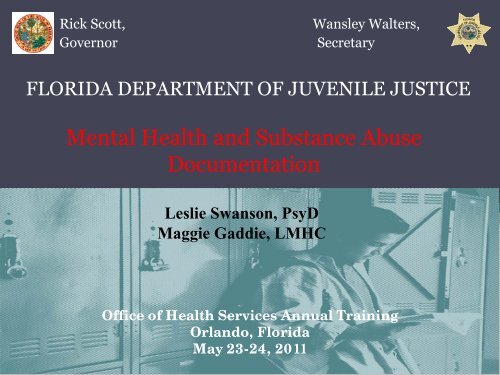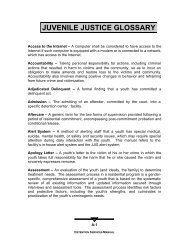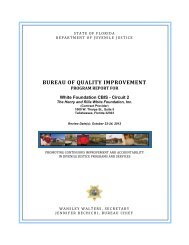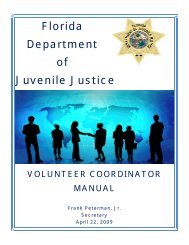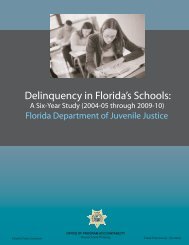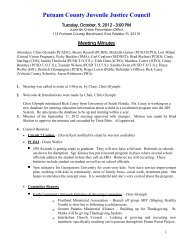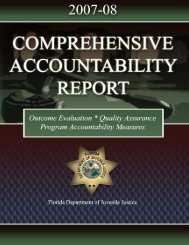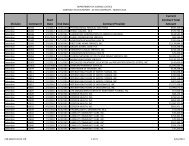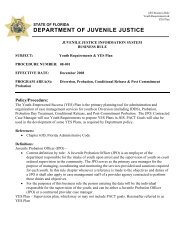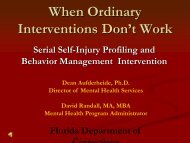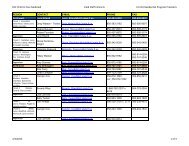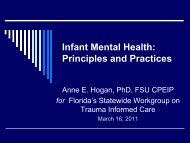Documentation - Mental Health Required Forms Assessment ...
Documentation - Mental Health Required Forms Assessment ...
Documentation - Mental Health Required Forms Assessment ...
You also want an ePaper? Increase the reach of your titles
YUMPU automatically turns print PDFs into web optimized ePapers that Google loves.
Rick Scott,<br />
Governor<br />
Wansley Walters,<br />
Secretary<br />
FLORIDA DEPARTMENT OF JUVENILE JUSTICE<br />
<strong>Mental</strong> <strong>Health</strong> and Substance Abuse<br />
<strong>Documentation</strong><br />
Leslie Swanson, PsyD<br />
Maggie Gaddie, LMHC<br />
Office of <strong>Health</strong> Services Annual Training<br />
Orlando, Florida<br />
May 23-24, 2011
Standardized <strong>Forms</strong><br />
1.Authority for Evaluation and Treatment (AET)<br />
and AET for Youth > 18 years – HS 002 and<br />
HS 003<br />
2.Youth Consent for Substance Abuse Treatment<br />
in RSAT or RSAT Overlay Program – MHSA<br />
001<br />
3.Suicide Risk Screening Instrument (SRSI) –<br />
MHSA 002<br />
4.PACT, MAYSI-2<br />
5.Suicide Risk Screening Parent/Guardian<br />
Notification – MHSA 003
Standardized <strong>Forms</strong><br />
6. <strong>Assessment</strong> of Suicide Risk (ASR) and<br />
Follow-up <strong>Assessment</strong> of Suicide Risk –<br />
MHSA 004 and MHSA 005<br />
7. Suicide Precautions Observation Log – MHSA<br />
006<br />
8. <strong>Health</strong> Status Checklist – MHSA 008<br />
9. Detention Suicide Risk Parent/Guardian<br />
Notification – MHSA 009<br />
10.<strong>Mental</strong> <strong>Health</strong>/Substance Abuse Treatment<br />
Discharge Summary -MHSA 011
Sample <strong>Forms</strong><br />
1. <strong>Mental</strong> <strong>Health</strong> Alert – Observation Log –<br />
MHSA 007<br />
2. Youth Consent for Substance Abuse Treatment<br />
–MHSA 012<br />
3. Youth Consent for Release of Substance Abuse<br />
Treatment Records - MHSA 013<br />
4. <strong>Mental</strong> <strong>Health</strong>/Substance Abuse Referral<br />
Summary - MHSA 014<br />
5. Initial <strong>Mental</strong> <strong>Health</strong>/Substance Abuse<br />
Treatment Plan - MHSA 015<br />
6. Individualized <strong>Mental</strong>/Substance Abuse<br />
Treatment Plan – MHSA 016
Sample <strong>Forms</strong><br />
7. Individualized <strong>Mental</strong>/Substance Abuse<br />
Treatment Review – MHSA 017<br />
8. Counseling/Therapy Progress Note – MHSA<br />
018<br />
9. Licensed <strong>Mental</strong> <strong>Health</strong> Professionals and<br />
Licensed/Certified Substance Abuse<br />
Professionals Direct Supervision Log – MHSA<br />
019<br />
10. Close Supervision –Visual Checks Log - MHSA<br />
020<br />
11. <strong>Documentation</strong> of Non-Licensed <strong>Mental</strong><br />
<strong>Health</strong> Clinical Staff Person’s Training in<br />
<strong>Assessment</strong> of Suicide Risk–MHSA 022<br />
12. Crisis <strong>Assessment</strong> – MHSA 023
Authority for Evaluation and<br />
Treatment<br />
• The department has been granted limited<br />
powers to:<br />
▫<br />
complete preliminary screenings (to<br />
determine mental health or substance<br />
abuse problems)<br />
▫ or if there is evidence of a mental health<br />
emergency<br />
• Beyond screening and emergency, the<br />
department must have consent to provide<br />
services
Authority for Evaluation and<br />
Treatment<br />
• In most circumstances, the<br />
AET gives DJJ the<br />
authority to assume<br />
responsibility for the provision of<br />
necessary and appropriate physical and<br />
mental health care to a youth in the DJJ’s<br />
physical custody<br />
• The AET does not give permission for<br />
substance abuse evaluation and<br />
treatment
Admission to Detention and Residential<br />
Programs<br />
DETENTION – JAC or JPO Unit<br />
Intake<br />
• PACT <strong>Mental</strong> <strong>Health</strong> and<br />
Substance Abuse Referral<br />
Form<br />
• MAYSI<br />
• SRSI<br />
▫ JPO<br />
▫ JDO<br />
▫ Nurse and/or mental health<br />
staff<br />
• Comprehensive<br />
<strong>Assessment</strong>s (SAMH2-3)<br />
RESIDENTIAL<br />
• Standardized MH/SA<br />
Screening Process<br />
▫ Review of commitment<br />
information<br />
▫ MAYSI (or)<br />
▫ Clinical MH/SA<br />
Screening
Suicide Risk Screening Instrument<br />
(SRSI)<br />
• JPO interviews youth and contacts<br />
parent/guardian, and if applicable, assigned<br />
JPO and DCF (pages 1-4)<br />
• Upon arriving at the detention facility, JDO<br />
conducting intake enters observations into SRSI<br />
(pages 3 & 4).<br />
• Nursing and/or mental health staff interview<br />
youth and enter data into SRSI (pages 5-8).
Suicide Risk Screening Instrument<br />
(SRSI)<br />
• Any “YES” responses on the SRSI result in the<br />
youth’s being placed on suicide precautions<br />
• JJIS will automatically generate a<br />
SUICIDE ALERT in JJIS for any “YES”<br />
responses.<br />
• JDO conducting intake must make a <strong>Mental</strong><br />
<strong>Health</strong> Referral and place youth on Suicide<br />
Precautions for any youth whose SRSI is positive<br />
upon entry to the facility.
<strong>Mental</strong> <strong>Health</strong>, Substance Abuse and<br />
Suicide Risk Screening<br />
Youth who are NOT screened at the JAC prior to<br />
entering the detention facility must undergo a<br />
screening based on available information at the<br />
detention facility.<br />
•The intake officer and/or Nursing and <strong>Mental</strong> <strong>Health</strong> staff<br />
at detention complete their sections of the SRSI, and if any<br />
positive responses, place the youth on suicide precautions<br />
and make a mental health referral for an assessment of<br />
suicide risk.
PACT <strong>Mental</strong> <strong>Health</strong> and Substance<br />
Abuse Screening Report & Referral<br />
• Immediate referral for assessment of suicide risk<br />
is indicated by the SRSI<br />
• Immediate referral for assessment of suicide risk<br />
is indicated by the PACT<br />
▫ Suicide scale<br />
▫ Depression (History of impairment in every day tasks<br />
due to depression/anxiety” Domain 3 <strong>Mental</strong> <strong>Health</strong>,<br />
item 3
PACT <strong>Mental</strong> <strong>Health</strong> and Substance<br />
Abuse Screening Report & Referral<br />
• A referral for further testing or services (e.g.<br />
comprehensive assessment) is indicated by PACT or<br />
screener override.<br />
* Suicide Scale * Depression<br />
* Aggression Scale *Substance Abuse<br />
* <strong>Mental</strong> <strong>Health</strong> Problems * Other
Standardized MH/SA Screening<br />
Process-Residential<br />
• Review of commitment information:<br />
▫ <strong>Mental</strong> health staff reviews commitment<br />
information including commitment packet,<br />
reports, or existing mental health documentation<br />
▫ <strong>Mental</strong> health professionals note any risk factors<br />
found in the review
Standardized MH/SA Screening<br />
Process-Residential<br />
• Risk factors can include, but are not limited to:<br />
▫ Inpatient/outpatient mental health or substance<br />
abuse treatment<br />
▫ Emergency room evaluations<br />
for mental health/substance abuse<br />
related issues<br />
▫ Suicide attempt, suicide behaviors or<br />
suicide risk<br />
▫ Self-injurious behaviors (e.g., head<br />
▫ banging, self-mutilation, intentional self-injury)
Standardized MH/SA Screening<br />
Process-Residential<br />
• Risk factors cont.<br />
▫ Treatment with psychotropic<br />
medications<br />
▫ Drug/alcohol use or<br />
drug/alcohol possession<br />
▫ Emotional instability (e.g.,<br />
depression, anxiety, mood<br />
swings, violent rage)<br />
▫ History of significant trauma<br />
▫ History of mental illness in<br />
family
Standardized MH/SA Screening<br />
• MAYSI-2<br />
Process-Residential<br />
▫ Should be conducted the day of admission in a<br />
private/confidential manner<br />
▫ Can only be administered by staff who have<br />
successfully completed CORE “Using the<br />
MAYSI-2 to Screen for <strong>Mental</strong> <strong>Health</strong> and<br />
Substance Abuse Problems”.<br />
▫ Should be conducted and recorded in JJIS
Standardized MH/SA Screening<br />
Process-Residential<br />
• The person conducting the MAYSI-2 should:<br />
▫ Use the provided script to explain the process<br />
▫ Give examples and explain the questions if needed<br />
▫ Provide enough time for the youth to answer<br />
▫ Determine if a referral for further assessment or<br />
immediate attention is to be made due to special<br />
circumstances (i.e. misreported by answering “no”<br />
to all items, refuses to answer, etc.)
Standardized MH/SA Screening<br />
Process-Residential<br />
• The person conducting the MAYSI-2 should:<br />
▫ Regardless of the MAYSI-2 findings, when<br />
the staff person obtains information that the youth<br />
has a mental health or substance abuse problem<br />
or is a possible suicide risk, a referral for further<br />
evaluation or immediate attention must be made.
Standardized MH/SA Screening<br />
Process-Residential<br />
• Clinical <strong>Mental</strong> <strong>Health</strong> and Substance Abuse<br />
Screening<br />
▫ Conducted by a licensed mental health<br />
professional<br />
▫ Must use valid and reliable instruments (i.e.<br />
SASSI-3, POSIT, etc.)<br />
▫ MUST include valid and reliable suicide risk<br />
screening instrument (i.e. Suicide Ideation<br />
Questionnaire or Suicide Probability Scale)
Standardized MH/SA Screening<br />
Process-Residential<br />
• Clinical <strong>Mental</strong> <strong>Health</strong> and Substance Abuse<br />
Screening (cont.)<br />
▫ Must reflect consideration of the following:<br />
• Recent <strong>Mental</strong> <strong>Health</strong>/Substance Abuse History<br />
• Recent History of Trauma and/or Victimization<br />
• Current <strong>Mental</strong> Status<br />
• Behavioral Observations<br />
• Suicide Risk Screening<br />
• Findings and recommendations for further evaluation<br />
or treatment<br />
• Disposition
Standardized MH/SA Screening<br />
Process-Residential<br />
• Clinical <strong>Mental</strong> <strong>Health</strong> and Substance Abuse<br />
Screening (cont.)<br />
▫ Must use a form that clearly states “Clinical <strong>Mental</strong><br />
<strong>Health</strong> and Substance Abuse Screening” on<br />
provider/program stationery<br />
▫ Must provide details of findings<br />
▫ Must be signed and dated by licensed clinician who<br />
completed the form<br />
▫ The clinician will make a decision regarding further<br />
evaluation/assessment , ASR, emergency evaluation,<br />
and confer with the program director and DMHA<br />
▫ The program director documents the consultation on<br />
the mental health substance abuse referral summary
Standardized MH/SA Screening<br />
• An ASR is required if:<br />
Process-Residential<br />
▫ The MAYSI-2 category “suicide ideations,” R-PACT<br />
Suicide Ideation Scale or Domain 3, Item 3 indicates<br />
the need for assessment<br />
▫ When other information is gathered that indicates<br />
need for an ASR (i.e. observations, information found<br />
in commitment packet, recent suicide<br />
ideations/attempts, etc.)
Standardized MH/SA Screening<br />
• An ASR is required if:<br />
Process-Residential<br />
▫ When the Clinical <strong>Mental</strong> <strong>Health</strong> and Substance Abuse<br />
Screening indicates need for an ASR or emergency<br />
mental health evaluation<br />
• ***A JJIS alert should be entered immediately and the youth<br />
be placed on suicide precautions (constant supervision) for any<br />
of the aforementioned scenarios<br />
• ***Youth with current suicide ideations must be assessed<br />
immediately
<strong>Mental</strong> <strong>Health</strong> and Substance Abuse<br />
Referral Summary<br />
• A MH/SA Referral Summary is generated in the<br />
following instances:<br />
▫ Positive SRSI<br />
▫ Elevated PACT Scales<br />
▫ Elevated MAYSI-2 Scales<br />
▫ Collateral information from parent/guardian, records,<br />
and/or observations of youth’s behavior<br />
▫ Information gathered in the Clinical <strong>Mental</strong> <strong>Health</strong><br />
and Substance Abuse Screening.<br />
▫ Reason for referral should be included in form e.g.,<br />
elevated PACT Suicide Scale, youth prescribed<br />
Depakote.
<strong>Mental</strong> <strong>Health</strong> and Substance Abuse<br />
Referral Summary<br />
Referral for the following services:<br />
• <strong>Assessment</strong> of Suicide Risk<br />
• Crisis <strong>Assessment</strong>/Intervention<br />
• Comprehensive <strong>Mental</strong> <strong>Health</strong>/Substance Abuse<br />
Evaluation or Updated Evaluation<br />
• <strong>Mental</strong> <strong>Health</strong> Consultation or <strong>Mental</strong> <strong>Health</strong> Support<br />
Services
<strong>Mental</strong> <strong>Health</strong>, Substance Abuse and<br />
Suicide Risk Screening<br />
DETENTION<br />
• If PACT or MAYSI-2<br />
Subscales are elevated, SRSI<br />
is positive, or<br />
intake/admission<br />
information indicates need:<br />
youth is referred by the JAC<br />
for a comprehensive<br />
assessment under Rule 63D,<br />
to be completed by a<br />
provider contracted with<br />
Probation.<br />
RESIDENTIAL<br />
• The program director is<br />
responsible for ensuring<br />
that comprehensive<br />
MH/SA evaluations or<br />
updated evaluations are<br />
received<br />
within 30 days of initial<br />
screening
<strong>Assessment</strong> of Suicide Risk<br />
The following will result in a placement of a youth<br />
on suicide precautions and referral for an<br />
<strong>Assessment</strong> of Suicide Risk (ASR):<br />
• Positive SRSI<br />
• Elevated PACT Suicide Scale on the PACT, or PACT<br />
Depression Subscale (“History of impairment in<br />
everyday tasks due to depression/anxiety” Domain 3-<br />
<strong>Mental</strong> <strong>Health</strong>, Item 3)<br />
• Elevated MAYSI-2 Suicide Ideation Scale<br />
• Other information gathered (i.e. observations, collateral<br />
information, etc.)
<strong>Assessment</strong> of Suicide Risk<br />
• Must be documented on form MHSA 004<br />
• Reason for <strong>Assessment</strong> of suicide risk<br />
• Method of <strong>Assessment</strong><br />
▫ Interview<br />
▫ Suicide Scale/Questionnaire<br />
▫ Testing<br />
• Current <strong>Mental</strong> Status Exam (to include direct<br />
questioning of the youth and collateral<br />
information)
<strong>Assessment</strong> of Suicide Risk<br />
• Suicide risk factors such as:<br />
▫ Current thoughts of suicide/harming self<br />
▫ Suicide plan and method<br />
▫ Youth’s confidence in his/her ability to carry out the<br />
plan<br />
▫ Availability/access to means to harm self<br />
▫ Precipitating stressful events<br />
▫ Previous attempts<br />
▫ Lethality of previous attempts<br />
▫ Psychiatric/mental health history<br />
▫ Drug abuse/dependence<br />
▫ Hopelessness
<strong>Assessment</strong> of Suicide Risk<br />
• Determining Dangerousness to Self:<br />
▫ Imminence of behavior<br />
▫ Intent of behavior<br />
▫ Clarity of danger<br />
▫ Lethality of behavior<br />
• Determination of Suicide Risk<br />
• Supervision recommendations<br />
• Summary of findings<br />
• Recommendations for treatment of follow up<br />
• Consultation with licensed MH Professional<br />
• Conferred with Facility Superintendant/Director<br />
• Notifications
Suicide Precautions<br />
Administrative and Clinical Reviews:<br />
• Following the removal of a youth from suicide<br />
precautions, administrative and clinical reviews by the<br />
facility superintendent/designee and licensed mental<br />
health professional (for ASRs completed by non-licensed<br />
clinical staff) are completed<br />
• Detention: documented in the ASR/FASR Disposition in<br />
DFMS.<br />
• Residential: documented on the paper ASR/FASR
<strong>Assessment</strong> of Suicide Risk<br />
• Follow-Up <strong>Assessment</strong> of Suicide Risk<br />
• Request for Discontinuation of Suicide<br />
Precautions<br />
• Disposition
<strong>Assessment</strong> of Suicide Risk<br />
Common Errors<br />
• Minimal information regarding reason for<br />
assessment.<br />
• Consultation with LMHP and/or<br />
Superintendent/Director does not include date<br />
and/or time of conferral.<br />
• Notification to parent/guardian is not made for<br />
youth who remain on suicide precautions following<br />
an initial (intake) ASR or for youth placed on suicide<br />
precautions during length of stay.<br />
• Recommendations not consistent with assessment<br />
data.<br />
• ASR not completed (including consult) w/in 24 hrs.
Suicide Risk Screening<br />
Parent/Guardian Notification<br />
• Detention Suicide Risk Parent/Guardian<br />
Notification (MHSA 009).<br />
▫ Youth released from detention prior to undergoing an<br />
ASR.<br />
▫ Youth released from detention after being assessed by<br />
mental health staff and placed/maintained on suicide<br />
precautions.
Suicide Risk Screening<br />
Parent/Guardian Notification<br />
• Suicide Risk Screening Parent/Guardian<br />
Notification (MHSA 003)<br />
▫ Youth whose screening indicated suicidal risk and are<br />
released from the JAC prior to undergoing an<br />
assessment.
Transfer to DJJ Facility While on<br />
• To a commitment<br />
facility:<br />
▫ Open JJIS alert<br />
▫ Observation log<br />
▫ Youth’s individual<br />
healthcare record should<br />
accompany the youth with<br />
appropriate mental health<br />
documentation present<br />
▫ Staff must notify new<br />
facility prior to or upon<br />
arrival/admission<br />
Suicide Precautions<br />
• To a detention<br />
center<br />
▫ Open JJIS alert<br />
▫ Observation log<br />
▫ Staff must notify new<br />
facility prior to or upon<br />
arrival/admission
Suicide Precautions<br />
Observation Log<br />
Maintained for youth on Precautionary or<br />
Secure Observation by direct care staff in<br />
order to monitor behavior, signs, and<br />
symptoms of youth on precautions
Suicide Precautions<br />
Observation Log<br />
• Behavior is documented at 30 minute intervals<br />
for youth on One to One or Constant<br />
Supervision.<br />
• Codes on form should be used<br />
• Log must be reviewed/signed by supervisors a<br />
minimum of every shift<br />
• Log must be reviewed/signed by mental health<br />
staff daily
Suicide Precautions<br />
Observation Log – Warning Signs<br />
Warning Signs (coded as 13 – 20) include the<br />
following:<br />
• Threats to harm self or others<br />
• Superficial attempts to hurt self<br />
• Possible hallucinations<br />
• Talking incoherently<br />
• Taking off clothes/stripping<br />
• Crying, very sad<br />
• Shaking/Trembling<br />
• Very sad and agitated or impulsive
Suicide Precautions<br />
Observation Log – Warning Signs<br />
• Warning signs must result in notification<br />
to Superintendent/Program Director and<br />
<strong>Mental</strong> <strong>Health</strong> Staff.<br />
• <strong>Documentation</strong> of notification is made on<br />
the logsheet, along with any instructions<br />
provided by mental health staff.
Suicide Precautions<br />
Observation Log<br />
Common Errors:<br />
▫ Missing entries<br />
▫ Warning signs without proper notifications<br />
▫ Entries not made in “real time”<br />
▫ Missing shift supervisor signatures<br />
▫ Missing mental health staff signatures
Secure Observation<br />
• Youth whose suicidal risk behavior requires level<br />
of observation and control beyond that provided<br />
by Precautionary Observation.<br />
• Youth who is in behavioral confinement and<br />
presents with suicidal behavior.<br />
• Youth on suicide precautions whose misbehavior<br />
results in placement on disciplinary<br />
confinement.
Secure Observation<br />
• <strong>Health</strong> Status Checklist (Form MHSA008)<br />
• Room Search<br />
• Youth Search<br />
• <strong>Assessment</strong> of Suicide Risk<br />
▫ Follow-up ASR<br />
▫ Disposition
Secure Observation<br />
• Time Frames:<br />
▫ DMHA or licensed MH professional MUST be<br />
contacted when initiated<br />
▫ ASR must be conducted within 8 hours of initiation,<br />
unless placement occurs during the evening or night<br />
shift. Then, the ASR must be completed the following<br />
morning shift<br />
▫ DMHA or licensed MH professional must give<br />
authorization for continuation of secure every 8 hours
<strong>Mental</strong> <strong>Health</strong> Alert<br />
Observation Log (MHSA 007)<br />
•Completed in the same manner as<br />
Suicide Precautions Observation Log for<br />
youth on One to One or Constant<br />
Supervision who are NOT on suicide<br />
precautions (Precautionary or Secure<br />
Observation).
Close Supervision<br />
Visual Checks Log<br />
• Youth undergoes visual checks a minimum of<br />
every 5 minutes while in his/her room<br />
• Log is not intended for youth on Suicide<br />
Precautions.<br />
• Used when youth is stepped down from<br />
suicide precautions (constant<br />
supervision) to close observation and<br />
transitioned to normal routine.<br />
• Can also be used for youth with a mental health<br />
alert.
Crisis <strong>Assessment</strong> (Form MHSA 023)<br />
• Crisis: a youth’s acute emotional or behavioral<br />
problem or psychological distress (e.g., anxiety,<br />
fear, panic, paranoia, agitation, impulsivity,<br />
rage) is extreme and does not respond to<br />
ordinary crisis intervention and mental health<br />
expertise is needed.
Crisis <strong>Assessment</strong> (Form MHSA 023)<br />
• Detailed evaluation of a youth demonstrating<br />
acute psychological distress (e.g., extreme<br />
anxiety, fear, panic, paranoia, agitation,<br />
impulsivity, rage) to determine the severity of<br />
his/her symptoms, and level of risk to self or<br />
others<br />
• Conducted by, or under the supervision of, a<br />
LMHP.<br />
• Reviewed within 24 hours if conducted by a nonlicensed<br />
clinician
Crisis <strong>Assessment</strong> (Form MHSA 023)<br />
Must include the following:<br />
▫ Reason for assessment<br />
▫ MSE and interview<br />
▫ Determination of dangerousness<br />
• Imminence of behavior/Intent/Clarity of danger/Lethality<br />
▫ Initial clinical impressions<br />
▫ Supervision and treatment recommendations<br />
▫ Recommendations for follow-up/further<br />
evaluation<br />
▫ Notification to parent/guardian of follow-up<br />
recommendations
Substance Abuse Consent/Release<br />
• For substance abuse services, in most instances<br />
a youth must consent to his or her treatment<br />
unless substance abuse evaluation and treatment<br />
have been ordered by the court.<br />
Section 397 F.S.<br />
Substance<br />
Abuse Services
Substance Abuse Consent/Release<br />
• Youth Consent for Substance Abuse Treatment<br />
in a DJJ RSAT or RSAT Overlay Services Pgm<br />
(MHSA 001)<br />
• Youth Consent for Substance Abuse Treatment<br />
(MHSA 012)<br />
• Youth Consent for Release of Substance Abuse<br />
Treatment Records (MHSA 013)
<strong>Mental</strong> <strong>Health</strong>/Substance Abuse<br />
Treatment Plans<br />
• All youth with a serious mental health disorder<br />
or substance abuse disorder, and getting mental<br />
health treatment while in a DJJ, facility should<br />
have an initial treatment or individualized<br />
treatment plan<br />
• The plan should focus on<br />
alleviating symptoms and<br />
allow the youth to function<br />
in the DJJ setting
Initial <strong>Mental</strong> <strong>Health</strong>/Substance Abuse<br />
Treatment Plans (MHSA 015)<br />
• Reason for treatment<br />
• Initial DSM-IV-TR diagnosis or presenting<br />
symptoms<br />
• Initial treatment methods<br />
▫ Duration/Amount/Frequency<br />
▫ Psychotropic medication and frequency of psychiatric<br />
monitoring
Initial <strong>Mental</strong> <strong>Health</strong>/Substance Abuse<br />
Treatment Plans (MHSA 015)<br />
• Initial goals and objectives<br />
• Detention: must be signed/dated by clinical staff<br />
and the youth.<br />
• Residential: must be signed/dated by clinical<br />
staff, youth and treatment team.
Initial <strong>Mental</strong> <strong>Health</strong>/Substance Abuse<br />
Treatment Plans Time Frames<br />
• Must be developed:<br />
▫ Within 7 days of initiation of treatment<br />
▫ OR for those youth on psychotropic medications,<br />
within 7 days of the initial psychiatric diagnostic<br />
interview<br />
• If developed by an non-licensed professional it<br />
must be reviewed and signed by a licensed MH<br />
professional (for the MH tx plan), or by a<br />
“qualified professional” (for SA tx plan) within<br />
10 days of completion
Mini Treatment Team<br />
Detention<br />
• Responsible for developing initial/individualized<br />
treatment plan<br />
• At least mental health staff and a person from<br />
different service area (i.e. medical)<br />
• Should involve parent/guardian (when possible)
Multi-Disciplinary Treatment Teams in<br />
Residential Programs<br />
• Composed of administration, educational, vocational,<br />
residential, medical, mental health, substance abuse<br />
and counseling components<br />
• Specialized treatment services programs (e.g., BHOS,<br />
MHOS, RSAT, RSAT Overlay), may utilize an initial<br />
treatment note or an initial treatment plan signed by<br />
the mental health/substance abuse clinical staff person<br />
and youth.<br />
• Follow-up appointments and contact names/numbers
Individualized <strong>Mental</strong><br />
<strong>Health</strong>/Substance Abuse Treatment<br />
Plans (MHSA 016)<br />
• Detention<br />
▫ Individualized Treatment Plans should be<br />
completed by the 31 st day when a youth stays<br />
beyond 30 days<br />
• Residential and Day Treatment:<br />
▫ Within 30 days of admission or for youths who<br />
begin treatment subsequent to admission, within<br />
30 days of initiation of treatment (including<br />
treatment with psychotropic medication).
Individualized <strong>Mental</strong><br />
<strong>Health</strong>/Substance Abuse Treatment<br />
▫<br />
▫<br />
▫<br />
Plans<br />
DSM-IV-TR Diagnoses and Symptoms<br />
MH/SA Treatment Goals<br />
MH/SA Treatment Objectives and<br />
Methods/Interventions<br />
• Symptoms<br />
• Objectives (Measurable/Achievable)<br />
• Methods/Interventions<br />
(Durations/Amt/Frequency)<br />
• Target Dates
Individualized <strong>Mental</strong><br />
<strong>Health</strong>/Substance Abuse Treatment<br />
Plans<br />
▫<br />
▫<br />
Psychiatric Services<br />
• Psychotropic medications<br />
• Frequency of psychiatric monitoring<br />
Youth and family strengths and needs
Treatment Plans<br />
Parent/Guardian Signatures<br />
• For both Initial and Individualized Treatment Plans)<br />
documented efforts should be made to have a<br />
parent/guardian signature, unless<br />
• There is clear documentation as to why signature is<br />
not present.<br />
▫ Non-involvement consistent with youth’s needs<br />
and/or statutory requirements;<br />
• Substance abuse treatment<br />
• Youth is emancipated (documented) or >18<br />
▫ Efforts to secure involvement have been<br />
unsuccessful.
Individualized <strong>Mental</strong><br />
<strong>Health</strong>/Substance Abuse Treatment<br />
Plan Review (MHSA 017)<br />
• The Individualized Treatment Plan must be<br />
reviewed every 30 days.<br />
• Any revisions to diagnoses, goals/objectives,<br />
methods/interventions or target dates are<br />
documented in Individualized MH/SA<br />
Treatment Plan Review (MHSA017)<br />
• The review should have signatures of youth,<br />
clinician, and treatment team members
Counseling/Therapy Progress Note<br />
(MHSA 018)<br />
• Provide a description of the treatment<br />
session/activity and the youth’s participation in<br />
the treatment session/activity. Document the<br />
course of treatment and the youth’s progress in<br />
meeting his/her clinical goals/objectives per<br />
treatment plan.<br />
• May be provided on the day treatment is<br />
provided or recorded weekly.
Weekly Progress Note/Summary<br />
Must include the following:<br />
• Summary of the treatment interventions delivered,<br />
youth’s response, progress, significant events, contact<br />
with family/other agencies.<br />
• Information that interventions authorized in treatment<br />
plan were delivered as per plan<br />
• Observations of staff’s implementation of plan<br />
• Summary of treatment team meetings related to youth<br />
• Substantiation that services were delivered each day that<br />
such were billed (including interventions and<br />
interactions of counselor and staff with youth)
<strong>Mental</strong> <strong>Health</strong>/Substance Abuse<br />
Discharge Summary (MHSA 011)<br />
• Final phase of treatment – transition phase.<br />
• Plan ideally developed by clinical staff, youth, and<br />
treatment team whereby improvements made<br />
during treatment will be maintained upon youths’<br />
movement between facilities or return to<br />
community.<br />
• Copies provided to youth, JPO<br />
and parent/guardian (as allowed).
<strong>Mental</strong> <strong>Health</strong>/Substance Abuse<br />
Discharge Summary (MHSA 011)<br />
• Dates treatment started/ended<br />
• Relevant MH/SA history<br />
• Reason MH/SA treatment initiated<br />
• Problems which were the focus of<br />
treatment<br />
• Course of treatment and youth’s progress<br />
• Pre/post treatment DSM-IV-TR diagnoses<br />
• Current alert status<br />
• Continued MH/SA service needs and treatment<br />
recommendations<br />
• Psychotropic medications
<strong>Assessment</strong> of Suicide Risk<br />
Non-Licensed <strong>Mental</strong> <strong>Health</strong> Clinical<br />
Staff Training<br />
• All non-licensed clinical staff conducting ASR’s<br />
must receive a minimum of 20 hours training<br />
and supervised experience in assessing suicide<br />
risk, mental health crisis intervention and<br />
emergency mental health services.<br />
NOTE: The non-licensed persons training and supervised<br />
experience must be provided by a licensed mental health<br />
professional
<strong>Assessment</strong> of Suicide Risk<br />
Non-Licensed <strong>Mental</strong> <strong>Health</strong> Clinical<br />
Staff Training<br />
• All non-licensed clinical staff conducting ASR’s<br />
must receive a minimum of 20 hours training<br />
and supervised experience in assessing suicide<br />
risk, mental health crisis intervention and<br />
emergency mental health services.<br />
• This includes administration of at least 5 ASRs<br />
or Crisis <strong>Assessment</strong>s conducted on site in the<br />
presence of a licensed mental health<br />
professional.<br />
(See Sample Form MHSA 022)
<strong>Assessment</strong> of Suicide Risk<br />
Non-Licensed <strong>Mental</strong> <strong>Health</strong> Clinical<br />
Staff<br />
• <strong>Documentation</strong> must include the DJJ ID#s of<br />
the 5 supervised assessments.<br />
• Please refer to Sample Form MHSA 022
Licensed <strong>Mental</strong> <strong>Health</strong> Professional’s<br />
and Licensed/Certified Substance<br />
Abuse Professional’s Direct Supervision<br />
Log (MHSA 019)<br />
• All non-licensed mental health professional must receive<br />
a minimum of 1 hour documented face to face<br />
supervision by a LMHP (psychiatrist, psychologist,<br />
LCSW, LMHC, LMFT, psychiatric nurse) per week
Licensed <strong>Mental</strong> <strong>Health</strong> Professional’s<br />
and Licensed/Certified Substance<br />
Abuse Professional’s Direct Supervision<br />
Log (MHSA 019)<br />
• All non-licensed substance abuse professionals must be<br />
provided a minimum of 1 hour documented face to face<br />
supervision per week by a “qualified professional” under<br />
Ch 397 (physician or physician assistant [licensed under<br />
458 or 459] , licensed psychologist, LCSW, LMFT,<br />
LMHC, an advanced registered nurse practitioner having<br />
a specialty in psychiatry licensed under part 1 of Chapter<br />
464, or a person who is certified through a DCF<br />
recognized certification process for substance abuse<br />
treatment)
Questions
74<br />
Contact Information<br />
Maggie Gaddie<br />
Senior Behavior Analyst – Central Region<br />
Phone: 813-740-4257<br />
Email: Maggie.Gaddie@djj.state.fl.us<br />
Leslie Swanson<br />
Senior Behavior Analyst – South Region<br />
Phone: 954-931-1352<br />
Email: Leslie.Swanson@djj.state.fl.us


